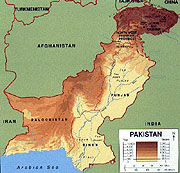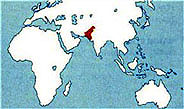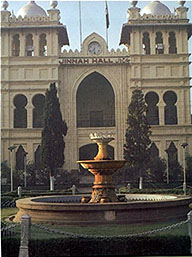
"A CASTLE WITH A THOUSAND DOORS" Pakistan is a country rich in history. From the time civilization began its initial development in the Indus River valley over five thousand years ago to the present, the people and cultures of the region have experienced a diverse set of changing influences. In the 1700s the British East India Company became the strongest power in South Asia, wresting control from the Mughal Empire, which had been created by invading Muslim Turks, and over time the British gained political control over much of the region. A series of wars fought in the Punjab and Sind in the 1840s added these territories to British control, and by 1900 British India included all of what is now Pakistan, India and Bangladesh. After World War I, both Indian nationalist leaders, such as Mohandas Gandhi, and the Muslim League called for South Asian independence. During the 1930s, the Muslim League increasingly began to prefer the creation of a separate Muslim nation. Muhammad Ali Jinnah, the League's president, opted to call the proposed country, "Pakistan," which means "land of the pure" in Urdu. After World War II, England committed itself to an independent South Asia. After unrest between Hindus and Muslims in the region, the United Kingdom and Hindu leaders agreed to a partition of the region. Pakistan became an independent country on 14 August 1947 with Muhammad Ali Jinnah as the first head of government. Fighting continued between Hindus and Muslims despite the partition. Hindus and Sikhs fled to India, while Muslims departed for Pakistan, a disaster. Thousands died in the scuffle. India and Pakistan also went to war over Kashmir in 1948. Pakistan claimed Kashmir because most of its residents where Muslim, while the region's Hindu leader made Kashmir part of India. The fighting ended only after the United Nations arranged for a cease-fire in 1949. Eventually in 1956, Pakistan became a republic with Major-General Iskander Mirza as the first president. Military leaders controlled the republican government. In 1965 the dispute over Kashmir led to renewed fighting, and once again, the United Nations had to arrange for a cease-fire. In 1970, representatives from East Pakistan (present-day Bangladesh) objected to West Pakistan's control of the nation's government, economy and armed forces. Elections were held for a new National Assembly responsible for drafting a revised constitution. But shortly after the elections, the differences and disagreements erupted in civil war. President Yahya Kahn, after inciting protests in East Pakistan, postponed the first meeting of the Assembly. Resisting the army, East Pakistan declared itself an independent country on 26 March 1971, "Bangladesh." In the early 1970s Kahn resigned, and Zulfikar Ali Bhutto restored constitutional government and civilian rule. Indian Prime Minister Indira Gandhi agreed to withdraw her troops from all Pakistan territories. Kashmir, however, remained in dispute, and Indian troops remained positioned there. In 1973 Pakistan adopted a new constitution that provided for a president as head of state and a prime minister as chief executive. Bhutto became Prime Minister, and Chaudhri Fazal Elahi was elected president. When Bhutto's political party was accused of election fraud in the mid-1970s, General Mohammed Zia-Ul-Haq declared martial law and removed Bhutto from office. Elahi resigned in 1978, and Zia declared himself president. His government convicted Bhutto of ordering the murder of a political opponent and executed him in 1979. Martial law ended in 1985 when Zia allowed the election of a new parliament. However, three years later he removed the prime minister and parliament from power, but later that year he died in a plane crash. Benazir Bhutto, daughter of Zulfikar Ali Bhutto and head of the Pakistan People's Party, was elected prime minister of the new parliament. She became the first woman to ever head an elected government in an Islamic nation. Ghulan Ishaq Khan became president and, in 1990 accused Bhutto of corruption and removed her from office. The Islamic Democratic Alliance, a coalition of reformist political parties, won a majority of parliamentary seats in the new October elections. Nawaz Sharif of the Pakistan Muslim League, the chief party of the coalition, became Prime Minister, but political unrest continued. In the mid-1990s military pressure dissolved Pakistan's parliament and Khan and Sharif resigned. Once more, Benazir Bhutto became prime minister. This time President Leghari accused her of corruption, and she was removed from office again three years later. A law passed by parliament in April 1997 stripped the Pakistani president of the powers to dismiss the prime minister and to call new elections. In October 1999 General Pervez Musharraf led a military coup to stop government corruption. He dissolved the parliament, suspended the Constitution and declared himself the head of a transition government; in 2001 he declared himself president. Musharraf incited protests from Pakistani supporters of Afghanistan's Islamic government when he allowed United States armed forces to operate in Pakistan during the war on terrorism. After India's Parliament building was attacked, causing the death and injury of 20 people, India blamed Pakistan of supporting terrorists. The incident led both countries to build up military forces along their common border, again threatening the fragile stability of the region.
1950 - 1959: 1951: Nazimuddin became the Prime Minister after Liaquat was assassinated 1956: The Constitution adopted; Governor General Mirza announced as President; 1958: Mirza declared martial law; he was sent into exile when General Mohammad Ayub Khan assumed the presidency. 1960 - 1969: 1965: Second war between India and Pakistan over Kashmir; cease-fire arranged by the United Nations; 1969: Ayub Khan resigned and martial law declared again; General Agha Mohammad Yahya Khan assumed the presidency. 1970 - 1979: 1971: East Pakistan attempted to secede and civil war broke out; East Pakistan declared an independent country named Bangladesh; Yahya Kahn resigned; Zulfikar Ali Bhutto elected President of Pakistan; 1972: Bhutto and Indian Prime Minister Indira Gandhi signed the SIMLA Agreement which created a new Line of Control; 1973: A new constitution was put into effect; Bhutto became Prime Minister; 1976: Diplomatic ties established between Pakistan and Bangladesh; 1977: General Mohammad Zia Ul-Haq proclaimed martial law; 1978: Zia became the sixth president of Pakistan; 1979: The Islamic penal code was introduced; Zulfikar Ali Bhutto was hanged for government corruption. 1980 - 1989: 1983: Zia lifted martial law; 1985: General elections were held: 1988: Zia dismissed the government and orders new elections; Zia killed in plane crash; Benazir Bhutto sworn in as the first female Prime Minister of an Islamic country. 
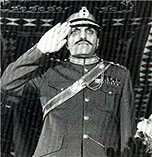
1990 - 1999: 1990: Bhutto lost to the coalition of rightist parties in the national election; Nawaz Sharif elected Prime Minister; 1995: Benazir Bhutto elected again as Prime minister by a slim margin; 1996: President Farooq Leghari accused Bhutto of government corruption and nepotism; Bhutto was dismissed from her position; 1997: Sharif became head of the government after national elections; 1998: Nuclear tests in India and Pakistan produced worldwide condemnation and sanctions from countries such as the United States and Japan; 1999: General Pervez Musharraf led the Pakistani army in a coup that toppled Sharif's government; Sharif was accused of massive corruption, destroying institutions and undermining the Constitution. 2000 - Present: 2000: A two-year drought forced hundreds of thousands of Pakistanis to leave the southern desert region; deposed Prime Minister Sharif tried for treason; 2001: Musharraf appointed himself President of Pakistan; Musharraf set a date of 1 October 2002 for the return of a democratic government; Pakistan shut down its border with Afghanistan preventing more refugees from entering; Pakistan joined and international coalition against terrorism at the United States' urging.  Flag: Pakistan's flag has a star and a crescent, both traditional symbols of Islam. Green stands for the nation's Muslim majority. Official Name: The Islamic Republic of Pakistan Capital: Islamabad Official Languages: Urdu and English (Others include: Punjabi, Sindhi, Siraiki, Pashtu, Balochi, Hindko, Brahui and Burushaski) Population: Estimated for 2002 at 144,135,000 (67% percent rural, 33% urban) Chief Agricultural Products: Wheat, Cotton, Rice, Sugar Cane, Milk and Chickpeas Mining: Natural Gas and Petroleum Manufacturing: Cotton Textiles and Clothing Money: Pakistani rupee Climate: Hot, dry desert; temperate in the northwest and arctic in the north; Annual rainfall of 36 inches. National Holiday: Pakistan Resolution Day (proclamation of the republic in 1956), 23 March
Some reference websites:
Some research websites:
Some official websites:
Some good books:
|
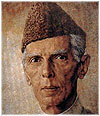 1940 - 1949: 1947: Pakistan
became an independent nation; Muhammad Ali Jinnah elected Governor General
with Liaquat Ali Khan as Prime Minister; 1948: Jinnah died; Kwaza Nazimuddin
became Governor General.
1940 - 1949: 1947: Pakistan
became an independent nation; Muhammad Ali Jinnah elected Governor General
with Liaquat Ali Khan as Prime Minister; 1948: Jinnah died; Kwaza Nazimuddin
became Governor General.